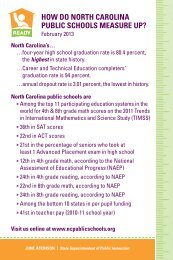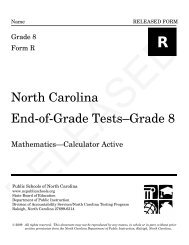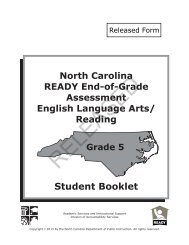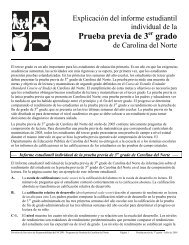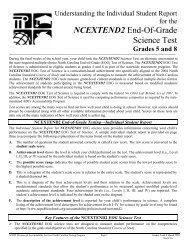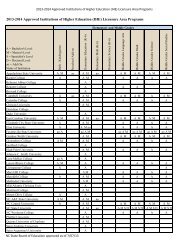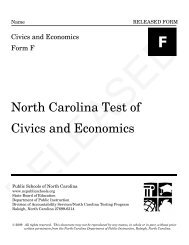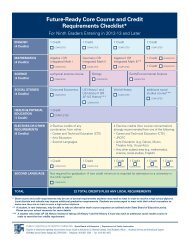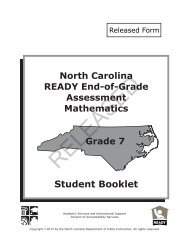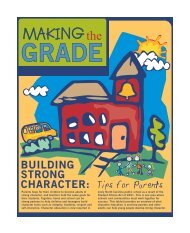Breaking Down Barriers - National Women's Law Center
Breaking Down Barriers - National Women's Law Center
Breaking Down Barriers - National Women's Law Center
You also want an ePaper? Increase the reach of your titles
YUMPU automatically turns print PDFs into web optimized ePapers that Google loves.
<strong>Breaking</strong> <strong>Down</strong> <strong>Barriers</strong><br />
A Legal Guide to Title IX<br />
and Athletic Opportunities<br />
The <strong>National</strong> Women’s <strong>Law</strong> <strong>Center</strong><br />
and DLA Piper<br />
Feb. 5, 2009<br />
© 2009 <strong>National</strong> Women’s <strong>Law</strong> <strong>Center</strong> 1
Who’s Who<br />
• NWLC: The <strong>National</strong> Women’s <strong>Law</strong> <strong>Center</strong> is a<br />
Washington-based nonprofit organization that has<br />
worked for over 35 years to expand opportunities<br />
and eliminate barriers for women and their families,<br />
with a major emphasis on women’s education and<br />
employment opportunities, health, and family<br />
economic security.<br />
• DLA Piper: DLA Piper is a global legal services<br />
organization with 3,200 lawyers located in 24<br />
countries and 63 offices throughout Asia, Europe,<br />
the Middle East, and the United States. Its clients<br />
include local, national, and global companies across<br />
a wide range of sectors. DLA Piper is committed to<br />
pro bono work and to helping its attorneys give<br />
back to their communities.<br />
© 2009 <strong>National</strong> Women’s <strong>Law</strong> <strong>Center</strong> 2
Speakers for this<br />
Session<br />
© 2009 <strong>National</strong> Women’s <strong>Law</strong> <strong>Center</strong> 3
Moderator:<br />
Robin Williams<br />
Associate<br />
DLA Piper<br />
Robin.Williams@dlapiper.com<br />
Since joining DLA Piper US LLP in 2000, Ms. Williams<br />
has handled a broad range of matters ranging from intellectual<br />
property claims to franchise and business disputes. She has<br />
worked most extensively in mass tort litigation involving<br />
consumer and pharmaceutical products. Ms. Williams was<br />
the team leader for the firm’s signature pro bono project which<br />
focused on providing research and editorial assistance to the<br />
<strong>National</strong> Women’s <strong>Law</strong> <strong>Center</strong> (NWLC) in connection with the<br />
publication of <strong>Breaking</strong> <strong>Down</strong> <strong>Barriers</strong>. She is also a member of<br />
Leadership 35, the NWLC's high-level advisory committee that<br />
provides the <strong>Center</strong> with advice and support on critical issues<br />
that affect women and their families.<br />
© 2009 <strong>National</strong> Women’s <strong>Law</strong> <strong>Center</strong> 4
Presenter:<br />
Neena Chaudhry<br />
Senior Counsel<br />
<strong>National</strong> Women’s <strong>Law</strong> <strong>Center</strong><br />
NChaudhry@nwlc.org<br />
Neena Chaudhry is Senior Counsel at the <strong>National</strong> <strong>Women's</strong><br />
<strong>Law</strong> <strong>Center</strong>, where since 1997 she has focused on gender equity<br />
in education issues, particularly Title IX. Ms. Chaudhry has<br />
served as counsel on key Title IX cases, engaged in legislative<br />
advocacy on behalf of women and girls, and addressed gender<br />
equity in education issues in the media and before key national<br />
audiences throughout the U.S.<br />
Ms. Chaudhry received her J.D. from Yale <strong>Law</strong> School and her<br />
B.A. from the University of Maryland at College Park.<br />
© 2009 <strong>National</strong> Women’s <strong>Law</strong> <strong>Center</strong> 5
Presenter:<br />
Christie Turner<br />
MARGARET Fund Fellow<br />
<strong>National</strong> Women’s <strong>Law</strong> <strong>Center</strong><br />
CTurner@nwlc.org<br />
Christie Turner is the MARGARET Fund Fellow at the <strong>National</strong><br />
Women’s <strong>Law</strong> <strong>Center</strong>, where she works on the Education and<br />
Employment team. Christie has worked on a variety of gender<br />
equity issues at the <strong>Center</strong>, including Title IX compliance in the<br />
areas of athletics and career and technical education. Thanks in<br />
part to Title IX, Christie is proud to have been a multiple sport<br />
high school athlete.<br />
© 2009 <strong>National</strong> Women’s <strong>Law</strong> <strong>Center</strong> 6
Survey Question<br />
Please share a little about yourself.<br />
Submit the answer that best<br />
describes you:<br />
• Attorney at a law firm<br />
• Attorney at a nonprofit organization<br />
• Government attorney<br />
• <strong>Law</strong> student<br />
• Educator<br />
• Advocate (non-lawyer)<br />
© 2009 <strong>National</strong> Women’s <strong>Law</strong> <strong>Center</strong> 7
Introduction<br />
• This presentation is based on the second edition of<br />
<strong>Breaking</strong> <strong>Down</strong> <strong>Barriers</strong>, which is available at<br />
http://www.nwlc.org/details.cfmid=3061§ion<br />
=athleticshttp://. .<br />
•<strong>Breaking</strong> <strong>Down</strong> <strong>Barriers</strong> is a guide to asserting Title<br />
IX claims challenging athletics discrimination. It<br />
provides a concise introduction to the enforcement<br />
of Title IX by private parties, with a focus on the<br />
rights of student-athletes.<br />
•<strong>Breaking</strong> <strong>Down</strong> <strong>Barriers</strong> is a resource primarily for<br />
plaintiffs and their attorneys, but also school<br />
counsel; university, middle, and high school<br />
administrators; women and girls in athletics; and<br />
others who are interested in familiarizing<br />
themselves with the governing legal principles.<br />
© 2009 <strong>National</strong> Women’s <strong>Law</strong> <strong>Center</strong> 8
Remember<br />
• The courts are not the only avenue for addressing sex<br />
discrimination in athletics, although they have been<br />
instrumental in opening up opportunities for many<br />
young women. Other options include:<br />
– working through an institution’s internal processes<br />
– filing complaints with federal/state administrative<br />
agencies, or<br />
– using media and public education strategies.<br />
– At the high school level in particular, school systems are<br />
often willing to correct inequalities through settlement<br />
agreements without the need for a lawsuit.<br />
• Individuals/organizations considering legal action<br />
should consult with their own counsel before deciding on<br />
a course of action. <strong>Breaking</strong> <strong>Down</strong> <strong>Barriers</strong> is intended to<br />
provide information on legal developments related to<br />
Title IX. It should not be construed as legal advice or a<br />
legal opinion on specific facts.<br />
© 2009 <strong>National</strong> Women’s <strong>Law</strong> <strong>Center</strong> 9
Overview of Presentation<br />
• Facts about Title IX and Athletics<br />
• Legal Principles Governing Title IX<br />
and Athletics<br />
• Challenges to Title IX’s Three-Part<br />
Test<br />
• Remedies in Title IX Athletics Cases<br />
• Selected Title IX Practice Issues<br />
• Legislative Developments<br />
© 2009 <strong>National</strong> Women’s <strong>Law</strong> <strong>Center</strong> 10
Facts about Title IX<br />
and Athletics<br />
© 2009 <strong>National</strong> Women’s <strong>Law</strong> <strong>Center</strong> 11
• Title IX of the Education Amendments<br />
of 1972 is the primary federal law<br />
barring sex discrimination in all facets<br />
of education, including athletics.<br />
• In the area of athletics, Title IX requires<br />
that:<br />
– members of both sexes have equal<br />
opportunities to play sports<br />
– athletic scholarships be allocated equitably<br />
– men and women be treated fairly with<br />
respect to the benefits and services<br />
accompanying participation<br />
© 2009 <strong>National</strong> Women’s <strong>Law</strong> <strong>Center</strong> 12
☺ Good News: Female Sports<br />
Participation Has Skyrocketed<br />
Girls’ Participation in Athletics Before and After Title IX<br />
4,500,000<br />
4,000,000<br />
3,500,000<br />
3,000,000<br />
2,500,000<br />
2,000,000<br />
GIRLS<br />
BOYS<br />
1,500,000<br />
1,000,000<br />
500,000<br />
0<br />
1971 2005-2006<br />
© 2009 <strong>National</strong> Women’s <strong>Law</strong> <strong>Center</strong> 13
☹ Bad News:<br />
Discrimination Persists<br />
• Women and girls at all levels of education<br />
are still being denied opportunities to play<br />
sports, and equal benefits and services<br />
when they do play.<br />
• While 53% of the students at Division I<br />
colleges are women, female athletes<br />
receive only 32% of total recruitment<br />
dollars, 37% of total athletic expenditures<br />
and 45% of total athletic scholarship<br />
dollars.<br />
© 2009 <strong>National</strong> Women’s <strong>Law</strong> <strong>Center</strong> 14
Legal Principles<br />
Governing Title IX<br />
& Athletics<br />
© 2009 <strong>National</strong> Women’s <strong>Law</strong> <strong>Center</strong> 15
Major Sources of Authority<br />
• Statute (1972): 20 U.S.C. §§ 1681-87<br />
• Regulations (1975) : 34 C.F.R. Part 106<br />
• Policy Interpretation, Title IX and Intercollegiate<br />
Athletics (1979): 44. Fed. Reg.<br />
71,413<br />
• Title IX Investigator’s Manual (1990)<br />
• Policy Clarifications Re: Three-Part Test<br />
(1996, 1998, 2003, and 2005)<br />
• OCR Policy Letters (e.g., 2000 and 2001<br />
letters re: cheerleading)<br />
© 2009 <strong>National</strong> Women’s <strong>Law</strong> <strong>Center</strong> 16
The Scope of Title IX<br />
• The Supreme Court has repeatedly held that<br />
Title IX is broad in scope:<br />
– All programs of an institution that receives<br />
federal money are covered.<br />
Civil Rights Restoration Act of 1987, overturning<br />
Grove City College v. Bell (1984)<br />
– It prohibits employment discrimination in<br />
federally funded education programs.<br />
North Haven Bd. of Educ. v. Bell (1982)<br />
– It prohibits retaliation against anyone who<br />
protests sex discrimination and is punished for it.<br />
Jackson v. Birmingham Bd. of Educ. (2005)<br />
© 2009 <strong>National</strong> Women’s <strong>Law</strong> <strong>Center</strong> 17
Definition of Recipient<br />
• All educational institutions that receive<br />
federal funds—including public and some<br />
private elementary and secondary schools<br />
and virtually all colleges/universities—are<br />
subject to Title IX.<br />
• Funds need not be received directly;<br />
indirect funding triggers coverage.<br />
• Institutions might be covered even absent<br />
a direct link to federal aid – e.g., Sixth<br />
Circuit has held that high school athletic<br />
association is subject to Title IX because it<br />
exercises “controlling authority” over<br />
member schools, which receive federal<br />
funds.<br />
© 2009 <strong>National</strong> Women’s <strong>Law</strong> <strong>Center</strong> 18
Title IX Athletics Framework<br />
• The Title IX regulations provide that “no person<br />
shall on the basis of sex, be excluded from<br />
participation in, be denied the benefits of, be treated<br />
differently from another person or otherwise<br />
discriminated against in any interscholastic,<br />
intercollegiate, club or intramural program.”<br />
• The Policy Interpretation sets forth three areas<br />
in which schools must treat males and females<br />
equally:<br />
1. Participation opportunities<br />
2. Athletic financial aid; and<br />
3. All other athletic benefits and opportunities.<br />
© 2009 <strong>National</strong> Women’s <strong>Law</strong> <strong>Center</strong> 19
Participation Opportunities<br />
• The Three-Part Participation Test: To<br />
comply with Title IX’s participation<br />
requirements, a school must demonstrate<br />
one of the following:<br />
– Prong 1: that the percentages of male and<br />
female athletes are substantially proportionate<br />
to the percentages of male and female students<br />
enrolled; or<br />
– Prong 2: that it has a history and continuing<br />
practice of expanding athletic opportunities for<br />
the underrepresented sex; or<br />
– Prong 3: that its athletics program fully and<br />
effectively accommodates the interests and<br />
abilities of the underrepresented sex.<br />
© 2009 <strong>National</strong> Women’s <strong>Law</strong> <strong>Center</strong> 20
Prong One<br />
• There must be a close fit between female<br />
and male enrollment and female and male<br />
athletic participation.<br />
– For example, a five percent disparity between<br />
female enrollment and participation is not<br />
substantial proportionality.<br />
• BUT, if the number of additional<br />
opportunities that would be provided if<br />
exact parity were achieved is not sufficient<br />
to sustain a viable team, the institution will<br />
be considered in compliance.<br />
© 2009 <strong>National</strong> Women’s <strong>Law</strong> <strong>Center</strong> 21
What Is a “Sport” <br />
• The Department of Education’s Office for Civil<br />
Rights (OCR) determines whether an activity is a<br />
sport, and thus whether participants in that activity<br />
can be counted as athletes, on a case-by-case basis,<br />
using a long list of factors, which include:<br />
whether selection for a team is based on<br />
objective factors related primarily to athletic<br />
ability;<br />
whether the activity is limited to a defined<br />
season;<br />
whether the activity is administered by the<br />
athletic department<br />
whether the primary purpose of the activity is<br />
athletic competition and not the support or<br />
promotion of other teams<br />
© 2009 <strong>National</strong> Women’s <strong>Law</strong> <strong>Center</strong> 22
Prong Two<br />
• A history of program expansion can be shown by:<br />
– Adding or upgrading teams;<br />
– Adding individual player slots; and<br />
– Affirmative responses to requests by students or others<br />
for addition or elevation of sports teams.<br />
• A continuing practice of program expansion can be<br />
established through evidence of:<br />
– An institution’s policy to allow student requests for the<br />
addition or elevation of sports teams and effective<br />
communication of the policy to students; and<br />
– An institution’s current implementation of a plan of<br />
program expansion that is responsive to developing<br />
interests or abilities.<br />
– But plans to expand women’s programs at some<br />
unspecified future date do not constitute the requisite<br />
program expansion!<br />
© 2009 <strong>National</strong> Women’s <strong>Law</strong> <strong>Center</strong> 23
Prong Three<br />
• An institution will be in compliance with<br />
Prong Three unless there is a sport for<br />
the underrepresented sex which meets<br />
the following conditions:<br />
a. Unmet interest sufficient to sustain a varsity<br />
team in the sport(s); and<br />
b. Sufficient ability to sustain an<br />
intercollegiate team in the sport(s); and<br />
c. A reasonable expectation of intercollegiate<br />
competition for a team in the school’s<br />
normal competitive region.<br />
© 2009 <strong>National</strong> Women’s <strong>Law</strong> <strong>Center</strong> 24
Assessing Unmet Interest<br />
• Under the 1996 Policy Clarification, schools<br />
must consider multiple factors, including:<br />
– Requests by students and admitted students to<br />
add or upgrade to varsity a particular sport;<br />
– Student participation in club or intramural<br />
sports;<br />
– Interviews with students, admitted students,<br />
coaches, administrators, and others regarding<br />
interest in particular sports;<br />
– Results of any interviews and questionnaires of<br />
students re: interests in particular sports; and<br />
– Past participation by admitted students in<br />
particular interscholastic sports.<br />
© 2009 <strong>National</strong> Women’s <strong>Law</strong> <strong>Center</strong> 25
Assessing Sufficient Ability<br />
• The focus under prong three should be on<br />
potential, not actual, ability of current and<br />
admitted underrepresented students to<br />
form varsity teams.<br />
• Indications of ability include:<br />
– Athletic experience and accomplishments in<br />
interscholastic, club or intramural competition;<br />
– Participation in other sports with similar skills<br />
and abilities required;<br />
– Self-assessment of the ability to compete;<br />
– Tryouts in the particular sport in which there<br />
is an interest; and<br />
– Opinions of coaches, administrators, and<br />
athletes regarding whether interested students<br />
have the potential to sustain a varsity team.<br />
© 2009 <strong>National</strong> Women’s <strong>Law</strong> <strong>Center</strong> 26
Assessing a Reasonable<br />
Expectation of Competition<br />
• If there is sufficient interest and potential<br />
ability, an institution fails Prong Three<br />
unless there is no reasonable expectation<br />
of competition in its normal competitive<br />
region.<br />
• Institutions may have an obligation<br />
actively to encourage the development of<br />
competition where opportunities for the<br />
underrepresented sex within their<br />
competitive region have been limited.<br />
© 2009 <strong>National</strong> Women’s <strong>Law</strong> <strong>Center</strong> 27
Have These Schools Met the<br />
Three-Part Test<br />
• Hogwarts High School has a student body that is<br />
49% male and 51% female. Its athletes are 51%<br />
male and 49% female.<br />
• Potter Regional High School last added a team for<br />
girls in 2003 and plans to add an equestrian team<br />
in 2009.<br />
• Snape School does not offer proportionate<br />
opportunities to girls and does not have a history<br />
and practice of adding opportunities for them. It<br />
has sent a survey to its female students asking<br />
about their athletics interests but got very few<br />
responses.<br />
© 2009 <strong>National</strong> Women’s <strong>Law</strong> <strong>Center</strong> 28
Athletic Financial Aid<br />
• Under Title IX, female and male shares of<br />
athletic financial aid must be substantially<br />
proportionate to the female and male<br />
shares of participation opportunities.<br />
• Focus is on the overall dollar amount<br />
provided rather than the number of<br />
scholarships.<br />
• In general, scholarship dollars awarded<br />
male and female athletes must be within<br />
one percent or one scholarship,<br />
whichever is greater, of their<br />
participation rates, absent a legitimate<br />
nondiscriminatory reason.<br />
© 2009 <strong>National</strong> Women’s <strong>Law</strong> <strong>Center</strong> 29
Other Athletic Benefits<br />
and Opportunities<br />
• Title IX requires equal treatment in all other<br />
aspects of athletic programs as well,<br />
including:<br />
– equipment and supplies;<br />
– scheduling of games and practice times;<br />
– travel and per diems;<br />
– opportunities to receive coaching and tutoring,<br />
and assignment and compensation of them<br />
– locker rooms and practice and competitive<br />
facilities.<br />
– medical and training facilities and services;<br />
– housing and dining facilities and services; and<br />
– publicity.<br />
© 2009 <strong>National</strong> Women’s <strong>Law</strong> <strong>Center</strong> 30
Is this a<br />
violation<br />
The girls’ softball<br />
field at Bowie<br />
High School <br />
The boys’<br />
baseball field at<br />
Bowie High<br />
School <br />
© 2009 <strong>National</strong> Women’s <strong>Law</strong> <strong>Center</strong> 31
Additional Points<br />
• There is no requirement that schools spend the<br />
same amount on male and female athletes, but<br />
differences in spending can raise red flags about<br />
second-class treatment.<br />
• That money is provided by a booster club or other<br />
outside funding to support a team is not a defense<br />
to disparities in benefits or services.<br />
• Provisions addressing coaching and tutoring create<br />
two sets of rights: those of the coaches/tutors not to<br />
be discriminated against and those of the studentathletes<br />
to receive equal quality coaching and<br />
tutoring.<br />
• Schools must treat males and females equally with<br />
respect to recruitment.<br />
© 2009 <strong>National</strong> Women’s <strong>Law</strong> <strong>Center</strong> 32
Challenges to Title IX’s<br />
Three-Part Test<br />
• ARGUMENT: Title IX imposes quotas.<br />
• RESPONSE:<br />
– The concept of quotas is misplaced in athletics<br />
because males and females are not competing for<br />
the same slots. Schools decide how many fixed<br />
opportunities they will provide to men and<br />
women, and the three-part test simply measures<br />
whether schools are allocating these<br />
opportunities equally. The federal courts have<br />
unanimously rejected the quota argument.<br />
– There are three separate ways to comply, so<br />
schools do not have to, and most don’t, satisfy<br />
proportionality.<br />
© 2009 <strong>National</strong> Women’s <strong>Law</strong> <strong>Center</strong> 33
• ARGUMENT: Title IX requires schools to cut men’s<br />
teams.<br />
• RESPONSE:<br />
– Title IX does not require or encourage schools to<br />
cut any teams, and the Department of Education<br />
has stated that cuts are disfavored.<br />
– Courts recognize that schools cut teams for<br />
numerous reasons unrelated to Title IX,<br />
including the desire to achieve a particular<br />
competitive level, changing interests of students,<br />
and budgetary demands.<br />
– Even when schools have reduced men’s<br />
opportunities in order to come into compliance<br />
with Title IX, courts have uniformly held that<br />
those decisions do not offend either statutory or<br />
constitutional standards.<br />
© 2009 <strong>National</strong> Women’s <strong>Law</strong> <strong>Center</strong> 34
Remedies in Title IX<br />
Athletics Cases<br />
– Damages (compensatory and possibly punitive)<br />
– Injunctive relief through reinstatement,<br />
instatement, or elevation of teams; ordering the<br />
hiring of coaches, the recruitment of players, or<br />
improvement of uniforms or facilities.<br />
– Equitable relief such as the award of<br />
scholarships denied because of discrimination<br />
– Award of attorneys’ fees to prevailing plaintiffs<br />
in litigation or as part of a settlement or courtordered<br />
consent decree.<br />
© 2009 <strong>National</strong> Women’s <strong>Law</strong> <strong>Center</strong> 35
Selected Title IX<br />
Practice Issues<br />
• Administrative exhaustion requirement<br />
– No. Title IX plaintiffs need not exhaust<br />
administrative remedies before bringing private<br />
actions.<br />
• Statutes of Limitations<br />
– Administrative complaints: complaints must be<br />
filed within 180 days of the discriminatory act,<br />
unless the Department of Education extends the<br />
time for filing.<br />
– Judicial Proceedings: The statute of limitations is<br />
that of the state cause of action most similar to the<br />
plaintiff’s claim, typically that applied to personal<br />
injury claims. Counsel should research this area<br />
carefully to determine the most appropriate statute<br />
of limitations.<br />
© 2009 <strong>National</strong> Women’s <strong>Law</strong> <strong>Center</strong> 36
Who has Standing to Sue<br />
in a Title IX Case<br />
• Depends on type of claim:<br />
– Participation claims: Courts have<br />
uniformly recognized that female students<br />
who seek to participate in a sport at a level<br />
not offered by the school have standing to<br />
bring a program-wide participation claim.<br />
– Scholarship and Treatment Claims:<br />
Students seeking to challenge inequities in<br />
scholarships and the treatment of athletes<br />
must already participate in the school’s<br />
athletic program.<br />
© 2009 <strong>National</strong> Women’s <strong>Law</strong> <strong>Center</strong> 37
Proof of Intent in Title IX<br />
Athletics Cases<br />
• Due to the sex-segregated nature of sports<br />
programs, any differing treatment of<br />
men’s and women’s teams by an<br />
educational institution constitutes<br />
intentional discrimination.<br />
• Intent under the law means a defendant’s<br />
intent to treat men and women differently,<br />
regardless of defendant’s subjective<br />
motive or ignorance of the law. There is<br />
no requirement to show animus, malice or<br />
any other evidence of motive.<br />
© 2009 <strong>National</strong> Women’s <strong>Law</strong> <strong>Center</strong> 38
Legislative Developments<br />
• The Equity in Athletics Disclosure Act (1994) is a<br />
federal law that requires colleges and universities<br />
to make publicly available an annual report on the<br />
athletic opportunities and resources provided to<br />
male and female students, including:<br />
– numbers of male and female participants<br />
– total operating expense for men’s and women’s sports<br />
– numbers of male/female head coaches<br />
– numbers of male/female assistant coaches<br />
– amount of athletic scholarship dollars allocated to<br />
males/females<br />
– salaries for coaches<br />
– amount of recruiting dollars allocated to males/females<br />
• There is no such requirement for high schools, but<br />
bills will be introduced in Congress soon<br />
addressing this issue.<br />
© 2009 <strong>National</strong> Women’s <strong>Law</strong> <strong>Center</strong> 39
Conclusion<br />
• Title IX and the developing case law set<br />
forth clear standards for schools to follow<br />
to ensure that they are treating their male<br />
and female students fairly in athletics.<br />
• Litigation has proven to be an essential<br />
tool in the fight to secure gender equity in<br />
athletics and will likely continue to play an<br />
important role.<br />
• Much work remains to be done to fulfill<br />
the promise of Title IX.<br />
© 2009 <strong>National</strong> Women’s <strong>Law</strong> <strong>Center</strong> 40
For More Information<br />
• About Title IX, please visit:<br />
– www.nwlc.org<br />
– www.titleix.info<br />
• About <strong>Breaking</strong> <strong>Down</strong> <strong>Barriers</strong>, including<br />
how to get a copy of the guide, please visit<br />
http://www.nwlc.org/details.cfmid=306<br />
1§ion=athleticshttp://<br />
• About how to get a copy of this<br />
presentation:<br />
– Stay tuned! We will send you an email<br />
with a link to this power point and a<br />
voice recording of today’s presentation.<br />
© 2009 <strong>National</strong> Women’s <strong>Law</strong> <strong>Center</strong> 41
Survey Question<br />
• We hope this webinar has been useful for<br />
you. Please let us know what you thought:<br />
– On a scale of 1 to 5, with 1 being the least<br />
helpful and 5 being the most helpful, how<br />
helpful was this webinar to you (1,2,3,4,5)<br />
© 2009 <strong>National</strong> Women’s <strong>Law</strong> <strong>Center</strong> 42
Questions<br />
• We will take questions by chat now.<br />
© 2009 <strong>National</strong> Women’s <strong>Law</strong> <strong>Center</strong> 43



